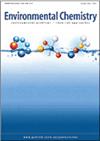澳大利亚南部海岸线的海水和底栖植物群中的药物污染
IF 2.3
4区 环境科学与生态学
Q3 CHEMISTRY, ANALYTICAL
引用次数: 2
摘要
大多数人类制药废物被排放到环境中。虽然淡水系统中药物的存在在全球范围内都有充分的记录,但对海洋生态系统的影响却知之甚少。我们测量了澳大利亚东南部海洋环境中的药物,发现底栖植物群中的药物浓度比海洋地面水中的药物浓度高24,000倍。我们讨论了海藻作为药物污染生物指标的潜在用途。药物是一种新兴的污染物,对生物和生态系统有一系列不利影响。它们在淡水和河口系统中的存在已经有了很好的记录,但它们在开阔海洋中的流行情况或底栖植物群对它们的吸收情况却知之甚少。这项对南澳大利亚海岸线的初步调查旨在测量地表水和底栖植物群中关键药物的浓度。本研究采用液相色谱-质谱联用技术(LC-MS/MS)测定了(1)污水处理厂、(2)海洋表层水体和(3)几种底栖生物群落样品中卡马西平、曲马多和文拉法辛的浓度。地表水和底栖生物区系在两个靠近污水处理厂排放点的地点和一个远离排放点的地点取样。结果地表水样品中均检出上述3种药物,并通过风险商将其风险评定为中度风险(卡马西平)和低风险(文拉法辛、曲马多)。在底栖植物群中也检测到这三种药物,特别是在棕色大型藻类中;曲马多在bankmosii中最高为34.7 ng g−1,文拉法辛在cephalornithos Caulocystis中最高为17.3 ng g−1。计算出的生物浓度因子表明,底栖植物群中的药物浓度比周围地表水高出约24 000倍。还有证据表明,靠近污水处理厂排放口会影响底栖植物群中药物的含量。结果表明,底栖生物群落可能是药物污染的合适生物指标,药物污染物对海洋生态系统的潜在影响有待进一步研究。本文章由计算机程序翻译,如有差异,请以英文原文为准。
Pharmaceutical pollution in marine waters and benthic flora of the southern Australian coastline
Environmental context Most human pharmaceutical waste is discharged to the environment. While the presence of pharmaceuticals in freshwater systems is well documented globally, little is known of the impact on marine ecosystems. We measured pharmaceuticals in a marine environment in south-eastern Australia and found pharmaceutical concentrations around 24 000 times higher in benthic flora than in the marine surface waters. We discuss the potential use of seaweeds as biological indicators of pharmaceutical pollution. Rationale Pharmaceuticals are emerging pollutants of concern with a range of adverse consequences for organisms and ecosystems. Their presence in freshwater and estuarine systems has been well documented, but less is known about their prevalence in open ocean, or their uptake by benthic flora. This preliminary survey of the southern Australian coastline sought to measure the concentrations of key pharmaceuticals in both surface waters and benthic flora. Methodology This study used LC-MS/MS to measure the concentration carbamazepine, tramadol and venlafaxine in (1) samples from wastewater treatment plants, (2) ocean surface waters and (3) several species of benthic flora. Surface waters and benthic flora were sampled at two sites near waste water treatment plant (WWTP) discharges, and one site away from any discharge. Results All three pharmaceuticals were detected in surface water samples with their risk assessed (via risk quotient) as medium risk (carbamazepine) or low risk (venlafaxine, tramadol). All three pharmaceuticals were also detected in benthic flora, particularly in brown macroalgae; Tramadol was measured at a maximum of 34.7 ng g−1 in Hormosira banksii, and Venlafaxine was recorded at a maximum of 17.3 ng g−1 in Caulocystis cephalornithos. Discussion The calculated bioconcentration factors suggest the pharmaceutical concentrations in benthic flora were up to ~24 000 times higher than in surrounding surface water. There was also evidence that proximity to WWTP outfalls influenced the levels of pharmaceuticals in benthic flora. The results suggest that the benthic flora may be suitable bioindicators of pharmaceutical contamination and that the potential impacts of pharmaceutical pollutants in marine ecosystems demand further investigation.
求助全文
通过发布文献求助,成功后即可免费获取论文全文。
去求助
来源期刊

Environmental Chemistry
环境科学-分析化学
CiteScore
4.50
自引率
0.00%
发文量
0
审稿时长
2.7 months
期刊介绍:
Environmental Chemistry publishes manuscripts addressing the chemistry of the environment (air, water, earth, and biota), including the behaviour and impacts of contaminants and other anthropogenic disturbances. The scope encompasses atmospheric chemistry, geochemistry and biogeochemistry, climate change, marine and freshwater chemistry, polar chemistry, fire chemistry, soil and sediment chemistry, and chemical aspects of ecotoxicology. Papers that take an interdisciplinary approach, while advancing our understanding of the linkages between chemistry and physical or biological processes, are particularly encouraged.
While focusing on the publication of important original research and timely reviews, the journal also publishes essays and opinion pieces on issues of importance to environmental scientists, such as policy and funding.
Papers should be written in a style that is accessible to those outside the field, as the readership will include - in addition to chemists - biologists, toxicologists, soil scientists, and workers from government and industrial institutions. All manuscripts are rigorously peer-reviewed and professionally copy-edited.
Environmental Chemistry is published with the endorsement of the Commonwealth Scientific and Industrial Research Organisation (CSIRO) and the Australian Academy of Science.
 求助内容:
求助内容: 应助结果提醒方式:
应助结果提醒方式:


